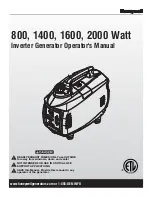
100402 - 2000W DUAL FUEL INVERTER GENERATOR
ASSEMbLY
17
Add Fuel: Propane (LPG)
1. Confirm the EZ Start dial is in the OFF position.
2. If using a new propane cylinder, remove the plastic cap
from the cylinder valve.
3. Attach the LPG hose assembly (included) to the propane
cylinder valve and hand tighten.
4. Remove the rubber boot covering the propane connection
port on the inverter.
5. Align the plastic finger on the male hose fitting on the
LPG hose assembly with the slot below the female quick
connect coupling on the inverter.
6. Insert the hose fitting into the quick connect coupling and
push in until you hear a “click” and the outside collar of the
quick connect coupling moves forward.
7. Check all connections for leaks by wetting the fittings with
a solution of soap and water. Bubbles which appear or
bubbles which grow indicate that a leak exists. If a leak
exists at a fitting then turn off the valve on the cylinder
and tighten the fitting. Turn the valve back on and recheck
the fitting with the soap and water solution. If the leak
continues or if the leak is not at a fitting then do not use
the generator and contact customer service.
NOTICE
–
The LPG hose included with this unit works with
standard 20 and 30 pound LPG tanks.
–
Verify the requalification date on the cylinder has not
expired.
–
All new cylinders must be purged of air and moisture
prior to filling. Used cylinders that have not been plugged
or kept closed must also be purged.
–
The purging process should be done by an LPG supplier.
(cylinders from an exchange supplier should have been
purged and filled properly already).
–
Always position the cylinder so the connection between
the cylinder valve and generator inlet won’t cause sharp
bends or kinks in the LPG hose.
CAUTION
Do not allow children to tamper or play with the LPG cylinder
or hose connections.
CAUTION
Use approved LPG cylinders equipped with an OPD
(overfilling prevention device) valve. Always keep the
cylinder in a vertical position with the valve on top and
installed at ground level on a flat surface. Cylinders must
not be installed near any heat source and should not be
exposed to sun, rain, and dust. When transporting and
storing, turn off the cylinder valve and generator LPG valve,
and disconnect the cylinder. Plug the outlet, usually by a
plastic protective cap, if one is available. Keep cylinders
away from heat and ventilated when in a vehicle.
WARNING
If there is a strong smell of LPG: Close valve on the cylinder.
Check all connections for leaks by wetting the fittings
with a solution of soap and water. Bubbles which appear
or bubbles which grow indicate that a leak exists. Do not
smoke or light a cigarette, or check for leaks using a match,
open flame source or lighter. Contact a qualified technician
to inspect and repair an LPG system if a leak is found,
before using the generator.
Grounding
Your generator must be properly connected to an appropriate
ground to help prevent electric shock.
WARNING
Failure to properly ground the generator can result in
electric shock.
A ground terminal connected to the frame of the generator has
been provided (see
Controls and Features
for terminal location).
For remote grounding, connect of a length of heavy gauge
(12 AWG minimum) copper wire between the generator ground
terminal and a copper rod driven into the ground. We strongly
recommend that you consult with a qualified electrician to
ensure compliance with local electrical codes.
Neutral Floating*
–
Neutral circuit
IS NOT
electrically connected to the frame/
ground of the generator.
–
The generator (stator winding) is isolated from the frame
and from the AC receptacle ground pin.
















































